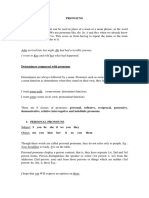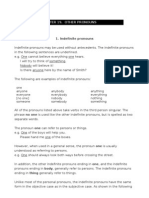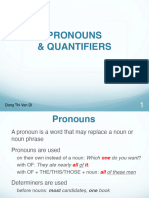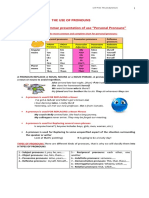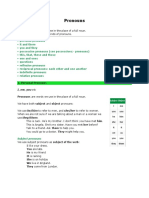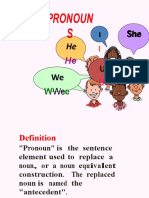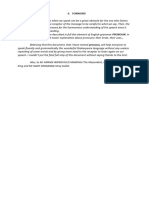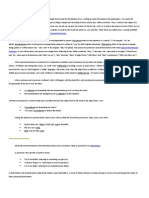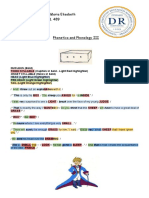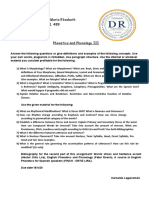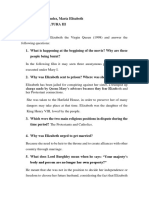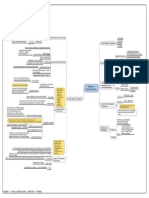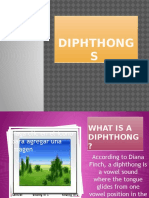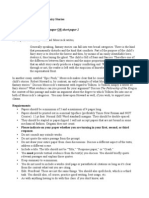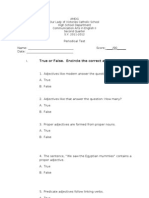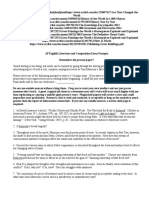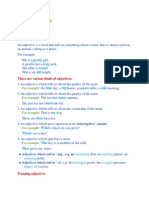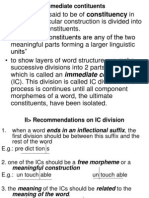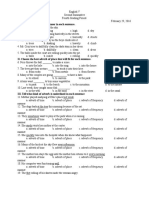Study Guide: Pronouns
1) How can you describe what a pronoun is and what it does? How are they different from determiners?
Definition: is a word that can be used in place of a noun or a noun phrase. We use pronouns like he she, it and
they when we already know who or what is referred to, the point to do this is to avoid the repition of the name or
the noun whenever we need to refer to it:
For example:
John arrived late last night. He had had a tiring journey.
Determiners are always followed by a noun. Words such as some and this followed by a noun function as
determiners. When they stand on their own, they function as pronouns:
For example:
Want some milk. (Some + noun, functioning as determiner)
Want some. (Some on its own, functioning as pronoun)
Want this book. (This + noun, functioning as determiner)
Want this. (This on its own, functioning as pronoun)
2) Classify all the pronouns you know in English. Consider order and number (i.e. first, second, third,
singular, plural person)
SECOND
FIRST
PERSON
PERSONAL
PRONOUNS
CASE
CONJOINT
FORM
NUMBER
GENDER
SINGULAR
______
ME
MY
PLURAL
______
WE
US
OUR
SINGULAR
______
PLURAL
______
SUBJECT OBJECT
YOU
SINGULAR MASCULINE
_____
REFLEXIVE
PRONOUNS
MINE
OURS
MYSELF
OURSELVES
YOUR
YOURS
YOURSELVES
HE
HIM
HIS
HIS
HIMSELF
SHE
HER
HER
HERS
HERSELF
ITS
---------
THEIR
THEIRS
_____
PLURAL
ABSOLUT
FORM
YOURSELF
FEMININE
THIRD
POSSESSIVE
PRONOUNS
IT
THEY
THEM
ITSELF
THEMSELVES
INTERROGATIVE PRONOUNS
WHO
WHOSE
WHAT
WHICH
It refers to persons. If who is the subject of the sentence, the predicate is in the singular. If who
is the predicative, the link verb agrees in number with the subject.
It is used to find out to which person something belongs to.
Usually refers to things, but it may be applied to persons when their profession, occupation is
meant.
SUBJECT: tell us whom
or what the sentence
is about.
DEMOSTRATIVE
PRONOUNS
May refer both to persons
and things, it is used
when choice is implied.
NUMBER
PRONOUNS
OBJECT: direct
objects, indirect
TO
objects, objectsREFERS
of prepositions.
SINGULAR
THAT
what isnouns
near in
and time
CONJOINTTHIS
FORM: is
used in before
inspace
the function
of an attribute.
PLURAL
ABSOLUTTHESE
FORM:
what isoffarther
is space and time
isTHOSE
never followed
a noun.
�INDEFINITE PRONOUNS
SINGULAR
PLURAL
SINGULAR OR PLURAL
Anybody anyone anything each either everybody everyoneeverything neither nobody no one nothing one somebody
someone something.
Both few many several.
All any most none some.
3) What does the term personal in personal pronouns refer to? What particular (especial) characteristics
do personal subject and object pronouns have?
The term personal in personal pronouns refers to signify the grammatical sense; personal pronouns are not
limited to people and can also refer to animals and objects ( this is the case of the pronoun it).
The Personal Subject, refers to whom or what the sentence is about; while the object pronouns refers to
direct objects, indirect objects and objects of preposition.
4) What are the special uses of the determiner One as a pronoun?
As an indefinite pronoun meaning 'everyone / anyone', is sometimes used (formally) in general
statements:
For Example:
World trade is improving, but one cannot expect miracles.
In everyday speech, the informal you is preferred:
For Example:
Can you buy refrigerators in Lapland? (= Can anyone ...?)
To replace /, but this tends to sound pompous:
For Example:
One likes to have one's breakfast in bed now and again.
One can be linked with one's, just as you can be linked with your- However, constructions with one, one's and
oneself are often awkward because of the repetition of oneFor Example:
One should do one's best at all times (For: You should do your best at all times)
One shouldnt be too hard on oneself (For: You shouldn't be too hard on yourself) In AmE one's/oneself can be
replaced by his/her, himself/herself- One should give himself/herself a holiday from time to time For the use of
the passive in place of one.
One and ones are frequently used as substitution words after a determiner (that one, etc). One(s) is
sometimes called a prop word because it 'supports' the meaning of the noun it replaces. One is used to
replace a countable noun in the singular and ones to replace a plural countable. One and ones can refer to
people or things and we use them when we wish to avoid repeating a noun:
THINGS
Have you seen this dictionary? (singular countable) Is that the one that was published
recently?
�Have you met our German neighbours? (plural countable) Are they the ones who moved here
PEOPLE recently?
We cannot use one when referring to an uncountable noun.
(Not *one*)
One and ones as prop words are most commonly used when we are identifying people and things,
particularly after Which? this/that, and adjectives. One and ones are optional after Which?, after this/that and
after superlatives. Ones can be used after these' those, though it is usually avoided:
Which (one) would you like? - This (one) or that (one)?
Which (ones) would you like? - These (ones) or those (ones)?
We normally use one/ones after the positive form of adjectives:
Which (one/ones) do you want? - The large one/ones
After colour adjectives, one and ones may be omitted in answers:
Which (one/ones) do you want? - I'll have the red (one/ones)
In statements, requests, etc. one and ones must be used after this/that/these/those + adjective:
Ill try on a few of these shirts. Please pass me that white one.
One and ones can be used in specific references after the definite article (the one/the ones),
demonstratives (this one) or with defining phrases (the one/ones with pink ribbons) to identify or to indicate the
location of people and things:
Which woman do you mean?
- The one in the green dress
5) Describe the functions of the pronoun IT: empty subject, preparatory subject, it in cleft
sentences, and preparatory object.
'IT' AS AN 'EMPTY SUBJECT'
We often use it in sentences referring to time, the weather, temperature or distance. When used in this way, it is
sometimes called an empty subject because it carries no real information. It is present because every English
sentence has to contain a subject and a verb
EXAMPLES
TIME
Its 8 o'clock - It's Tuesday - It's May 25th.
IT'S TIME...
It's time (for us) to leave
WEATHER
Its hot - It's raining -It rains a lot here..
TEMPERATURE
It's 37 centigrade / Celsius.
DISTANCE
It's 20 miles to / from London.
THE TIDES
It's high tide at 11. 44
ENVIRONMENT
PRESENT SITUATION
WITH SINCE
It's noisy/smoky in here.
Isn't it awful! - Isn't it a shame!
It's three years since we last met.
WITH SAYS
It says here there was a big fire in Hove.
WITH TAKE
It takes (us) half an hour to get to work.
And note many expressions with it, e.g. it doesn't matter, it's no use, (it as subject);
I've had it; That does it? (it as object).
'IT AS A PREPARATORY SUBJECT'
Sometimes sentences beginning with it continue with an infinitive, a gerund or a noun clause. It is possible to
begin such sentences with an infinitive or gerund, but we generally prefer it:
Its pleasant to lie in the sun (To lie in the sun is pleasant)
�Its pleasant lying in the sun (Lying in the sun is pleasant)
It's a shame that Tom isn't here (That Tom isn't here is a shame)
It doesn't matter when we arrive (When we arrive doesn't matter)
The true subject in the above sentences with it is the infinitive, gerund or noun clause and it is preparatory to
the subject. It as a preparatory subject often combines with:
EXAMPLES
ADJECTIVES
E.g.: difficult, easy, important, vital.
It's easy (for me) to make mistakes.
NOUNS
E.g.: fun, a pity, a pleasure, a shame
It's a pleasure (for us) to be here
VERBS
E.g.: appear, happen, look, seem
It appears that he forgot to sign the letter
It now looks certain that the fire was caused
by a cigarette end.
THE USE OF 'IT' IN 'CLEFT SENTENCES'
We can begin sentences with It is or It was + subject + that or who (m), if we wish to emphasize the word or
phrase that follows. Sentences formed in this way are called cleft sentences because a simple sentence is split up
(cleft) into two clauses using the it- construction:
Freda phoned Jack last night (simple sentence, no emphasis)
It was Freda who phoned Jack last night (and not Rita)
It was Jack who (m) Freda phoned last night (and not Richard)
It was last night that Freda phoned (and not this morning)
'IT' AS A 'PREPARATORY OBJECT'
IT + ADJECTIVE: can be used after verbs like find to prepare us for the infinitive or the that clause that
follows:
For Example:
+ INFINITIVE: Tim finds it difficult to concentrate
+ F / IAF - CLAUSE: Jan thinks it funny that I've taken up yoga
It can also be used after verbs like enjoy, hate, like, love.
For Example:
I don't like it when you shout at me.
6) Specific and non-specific uses of it, they, one, some.
7) Uses of it and so with some verbs, and in certain verbs constructions.
8) Whats the difference between possessive adjectives and possessive pronouns? How do we use my
own?
9) When are reflexive pronouns obligatory? What are the functions of reflexive pronouns?
�10) Whats the difference between demonstrative adjectives and demonstrative pronouns?
11) What indefinite pronouns? Whats their form? Which are the uses of the some/any/no/every
compounds?
12) Which are the uses of indefinite pronouns?
13) The determiners each other and one another (5.28 Alexander) are considered Reciprocal
Pronouns. Which are their uses?
Each other => (used to refer to two people)
One another => (used to refer to more than two)
In everyday speech, both phrases are normally interchangeable
For Example:
Karen and Dave are deeply in love with each other/one another.
Both phrases can be used with ans.
For Example:
Those two are always copying each other's/one another's homework
14) Hows the form of Relative Pronouns in relative clauses (1.27 Alexander). Describe them and their
uses.
RELATIVE PRONOUNS AS SUBJECT
PEOPLE
He is the man who (or that) lives next door
THINGS
That is the photo which (or that) shows my car
POSSESSION
She is the woman whose purse was stolen
RELATIVE PRONOUNS AS OBJECT
People
He is the man {who/whom/that) I met
People
He is the man ( - ) I gave the money to
Things
This is the photo (which/that) I took
Things
This is the pan { - ) I boiled the milk in
POSSESSION: IT WAS AN AGREEMENT THE DETAILS OF WHICH COULD NOT BE ALTERED
Relative pronouns as subject:

